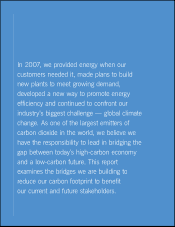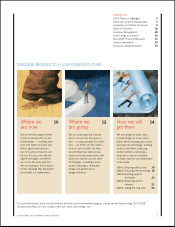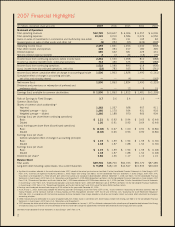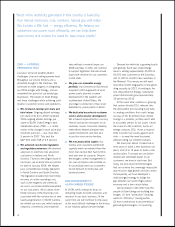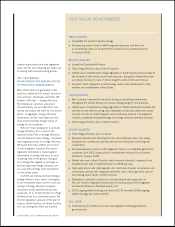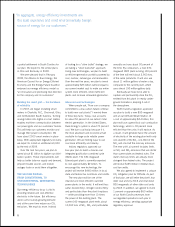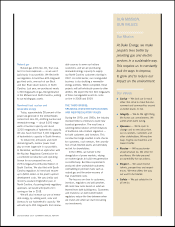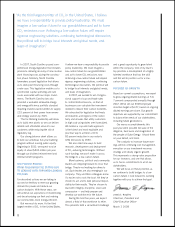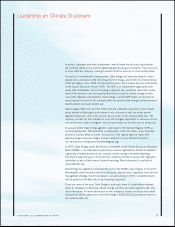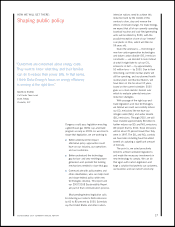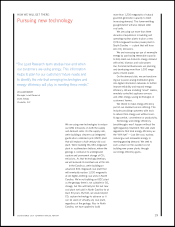Duke Energy 2007 Annual Report Download - page 11
Download and view the complete annual report
Please find page 11 of the 2007 Duke Energy annual report below. You can navigate through the pages in the report by either clicking on the pages listed below, or by using the keyword search tool below to find specific information within the annual report.
DUKE ENERGY 2007 SUMMARY ANNUAL REPORT 9
Investors, customers and other stakeholders need to know the risks and opportunities
the company will face in a world of tightening greenhouse gas constraints. They also want
to know what the company is doing to position itself for success in a low-carbon future.
As part of its commitment to transparency, Duke Energy has been reporting its carbon
dioxide (CO2
) emissions to the U.S. Department of Energy and to the U.S. Environmental
Protection Agency since 1995. For the past five years, the company has also participated
in the Carbon Disclosure Project (CDP). The CDP is an independent organization that
works with shareholders and participating companies who voluntarily share their assess-
ment of the business risks and opportunities they face due to climate change and the
associated regulatory requirements. Duke Energy’s current CDP report can be found at
www.cdproject.net and on the company Web site at www.duke-energy.com/environment/
reports/carbon-disclosure-project.asp.
Duke Energy’s SEC Form 10-K for 2007 included a detailed assessment of the climate
policy debate in Washington and potential costs customers could see under specific
legislative proposals. (This form can also be accessed on the company Web site.) The
company pointed out that compliance costs will be highly dependent on allowance prices,
and will be tied closely to Congress’ decision with respect to the allocation of allowances.
In January 2008, Duke Energy agreed to participate in The Climate Registry (TCR) as
a Founding Reporter. TCR represents a collaboration of 39 U.S. states, seven Canadian
provinces and two Mexican states. Participants in the registry agree to report their
greenhouse gas emissions using a common platform. A more detailed description
can be found by visiting www.theclimateregistry.org.
In 2007, Duke Energy joined the Advisory Committee of the Climate Disclosure Standards
Board (CDSB) — an international partnership of seven organizations formed to establish
a generally accepted framework for corporate climate change risk-related reporting.
The board’s long-term goal is to ensure that companies file these reports with regulatory
authorities as part of their annual financial reporting. More information is available at
www.weforum.org.
Duke Energy has agreed to participate this year in the CDSB’s pilot program to “road test”
the template, which includes emissions disclosure, physical risks, regulatory risks and risk
management strategy. Once the program is up and running in 2009, completed reports
will be posted on the Web sites of participating companies.
These are some of the ways Duke Energy is working to keep its stakeholders informed
about its strategy for addressing climate change and the associated regulatory risk, now
and in the future. For more information on the company’s climate disclosure and overall
transparency efforts, please also see Duke Energy’s 2007|2008 Sustainability Report on
the company Web site.
Leadership on Climate Disclosure


